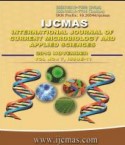


 National Academy of Agricultural Sciences (NAAS)
National Academy of Agricultural Sciences (NAAS)

|
PRINT ISSN : 2319-7692
Online ISSN : 2319-7706 Issues : 12 per year Publisher : Excellent Publishers Email : editorijcmas@gmail.com / submit@ijcmas.com Editor-in-chief: Dr.M.Prakash Index Copernicus ICV 2018: 95.39 NAAS RATING 2020: 5.38 |
Tomato crop exhibited symptoms occurring on the oldest leaves as small, brownish to black lesions which are due to foliar blight disease and it was caused by a complex of mycoflora viz, Alternaria solani, Fusarium oxysporum and Curvularia lunata. The disease complex causes considerable yield as well as post-harvest losses. A. solani produced blackish, fluffy mycelium with septate, beaked conidia on PDA. Fusarium oxysporum exhibited dull to fluffy white mycelium with slight faint reddish tinge at the middle. Curvularia lunata had septate mycelium which was black in the periphery and brownish black in the middle with tri-septate conidia. The growth of three fungal pathogens were tested under eight different solid media and compared with each other. Maximum radial growth of A. solani (63.00mm), F. oxysporum (60.50mm) and C. lunata (58.10mm) was supported by PDA. Oat meal agar supported better growth (42.33mm) next to PDA for A. solani, Brown’s agar supported better growth next to PDA for F. oxysporum (27.17mm) & C. lunata (54.73 mm). Sabouraud’s agar, Malt extract agar and Richard’s agar showing least radial growth for Alternaria solani (10.60mm), Fusarium oxysporum (9.77mm) and Curvularia lunat (12.83mm) respectively. The study will be helpful for further investigation on the physiology of the fungus and management of disease. The investigation may be useful for taxonomic study of the fungus.
 |
 |
 |
 |
 |